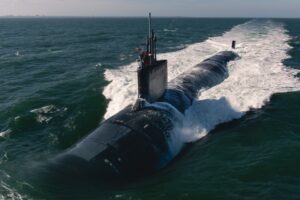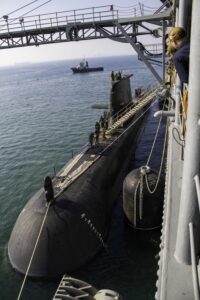The tripartite U.S., U.K. and Australia AUKUS agreement to share nuclear-powered attack submarines with Australia will have the U.S. sell up to five Virginia-class submarines before the U.K. and Australia build new shared design, dubbed SSN-AUKUS submarines.
The announcement made on Monday is the culmination of an 18-month exploratory review period by the countries, resulting in a three phased plan It aims to improve the submarine industrial base of all three countries, senior administration officials told reporters on Sunday, ahead of the Monday announcement by President Biden, British Prime Minister Rishi Sunak and Australian prime Minister Anthony Albanese in San Diego.

The first phase is already underway but set to ramp up over the following years with U.S. and U.K. submarines visiting ports in Australia more frequently, Australian sailors increasingly embedding in U.S. and U.K. attack submarine forces and the nuclear power schools, and “in the coming months there’ll be Australian workers in our shipyards,” one senior administration officials said.
The officials highlighted the Los Angeles-class USS Asheville (SSN-758) is currently in Perth, Australia for combined training exercises.
According to a fact sheet released with the leaders’ statement, the U.S.Navy plans to increase SSN port visits to Australia this year with Australian sailors joining American crews for training and development while the U.K. will increase its visits starting in 2026.
This will lead into setting up a rotational force of up to four U.S. Virginia-class submarines and one U.K. Astute-class submarine based at HMAS Stirling near Perth, Australia, dubbed Submarine Rotational Forces (SRF) West. SRF West may be established as early as 2027.
“This rotational force will help build Australia’s stewardship. It will also bolster deterrence with more U.S. and U.K. submarines forward in the Indo-Pacific,” an official said.
The SRF West submarines will still operate under their respective countries’ commanders, but the administration expects there will be a “significant degree of coordination in their activities.”
In phase two, once Australia has enough trained sailors by the early 2030s, it plans to buy three Virginia-class submarines with an option for two more, pending approval by the U.S. Congress.
“This will help systematically grow Australians’ capabilities and stewardship for nuclear powered submarines and it will help ensure that Australia does not experience any capability gap when its current Collins-class diesel electric subs are retired in in the 2030s,” a senior administration official said.
“This means that Australia will have a potent nuclear-powered submarine force in the 2030s, much earlier than many had expected,” they continued.
Phase three will start in the late 2030s, with Australia and the U.K. both building and fielding a new nuclear-powered attack submarine design, called SSN-AUKUS. By this time, Australia’s industrial base is expected to be ready to start building the new vessel. The fact sheet stated both Australia and the U.K. intend to start building SSN-AUKUS vessels in their shipyards before the decade ends.

The senior administration officials said SSN-AUKUS will be based on the U.K.’s design for its next-generation SSN, previously called SSN(R), but now incorporating unspecified “critical cutting edge Virginia-class technologies from the United States.”
SSN(R) was previously planned to replace the U.K.’s current Astute-class nuclear-powered attack submarines. The U.K. currently fields four of the boats while three more are in sea trials or under construction. Now SSN-AUKUS will replace SSN(R) for the U.K., but the design work that they did will be useful and the discussions about how to effectively integrate Virginia-class technology into that have already begun,” the officials said,
The administration officials argued SSN-AUKUS will use the best of U.S., U.K. and Australian technologies.
The U.K. plans to deliver its first domestically-produced SSN-AUKUS in the late 2030s while Australia will deliver its own submarine in the early 2040s. The officials acknowledged it will take Australia somewhat longer to deliver its SSN-AUKUS vessels because they do not have an existing submarine industrial base.
The officials said they expect there will be components that each of the three countries provide for SSN-AUKUS vessels, even while most of the production and final assembly will occur in their respective countries.
The officials confirmed they have estimates of when SSN-AUKUS designs need to be completed to match this schedule and as the three countries work to develop this plan they will “have more precise estimates in coming months.”
An official acknowledged this plan will “require significant improvements and industrial bases in all three countries,” but the administration briefed Congress about the plan and they “see strong bipartisan support.”
Including the fiscal year 2023 investment into the U.S. submarine industrial base, this plan entails adding $4.6 billion for production and maintenance funds over the next five years in while Australia will additionally contribute an undisclosed “substantial contribution” to the U.S. industrial base, one official said.
This is “another manifestation of just how serious and critical this effort is. That has been decided based on the principles of proportionality, fairness, and transparency,” the official added.
Moreover, one official admitted the U.S. is “not where it should be,” but between DoD budget requests and plans to expand it plus the Australian contribution, they called this a “generational opportunity to lift the submarine industrial bases” for the U.S. and U.K. while also building one for Australia.
The fact sheet noted Australia is committed to a “proportionate financial investment in the U.S. submarine industrial base to accelerate delivery of Virginia-class submarines.”
The officials also said they are confident the U.S. government will be able to move past export restrictions in sharing these kinds of defense technologies without slowing down the plan.
“We are looking at what changes to our current export control arrangements would be appropriate to ensure that we’re able to move at the speed of relevance in our cooperation with the U.K. and Australia in these areas,” one official said.
Another official said given how close an ally Australia is for the U.S., the administration feels “very confident that they will take this unique capability in a responsible fashion.”
The official also argued the AUKUS deal is “just a manifestation” of how Russia’s invasion of Ukraine further underscored the need for U.S. to invest in its industrial base alongside its allies.
This deal’s provisions of Virginia-class submarines for Australia is in line with what Secretary of Defense Lloyd Austin said in December, committing to help ensure Australia did not have a capability gap between its Collins-class submarines retiring and the AUKUS vessels coming into service (Defense Daily, Dec. 7).
Last October, Rep Rob Wittman (R-Va.), then-ranking member of the House Armed Services subcommittee on seapower and projection forces, said he thought BWX Technologies [BWXT] will make the reactors for the eventual Australian submarines but also argued the U.S. should not build initial submarines for Australia due to the already-stressed American industrial base (Defense Daily, Oct 10, 2022).
At the time, Wittman argued American industry needs to build up to being able to alternate building two and three attack submarines annually then start a joint deployment agreement with Australia where both countries jointly command a Virginia-class submarine filled with Australian submariners so it remains an American asset.
Last July, Wittman also emphasized the AUKUS cooperation has to start with not just Australian sailors training at U.S.Navy nuclear schools and deploying on American attack submarines. In addition, that effort also includes Australian shipbuilders working with and at American shipyards to gain experience building SSNs (Defense Daily, July 27, 2022).
However, back then, Wittman also opposed selling Virginia-class vessels to make up for the post-Collins capability gap.
Last July, Deputy Prime Minister and Defense Minister of Australia Richard Marles noted the export control barriers among all three countries need to be broken down to share the AUKUS technology and said extending the service life of the Collins-class submarines was inevitably going to become part of the plan (Defense Daily, July 15, 2022).
The American officials did not disclose if extending the Collins-class submarines will proceed in addition to Australia buying the Virginia-class boats.